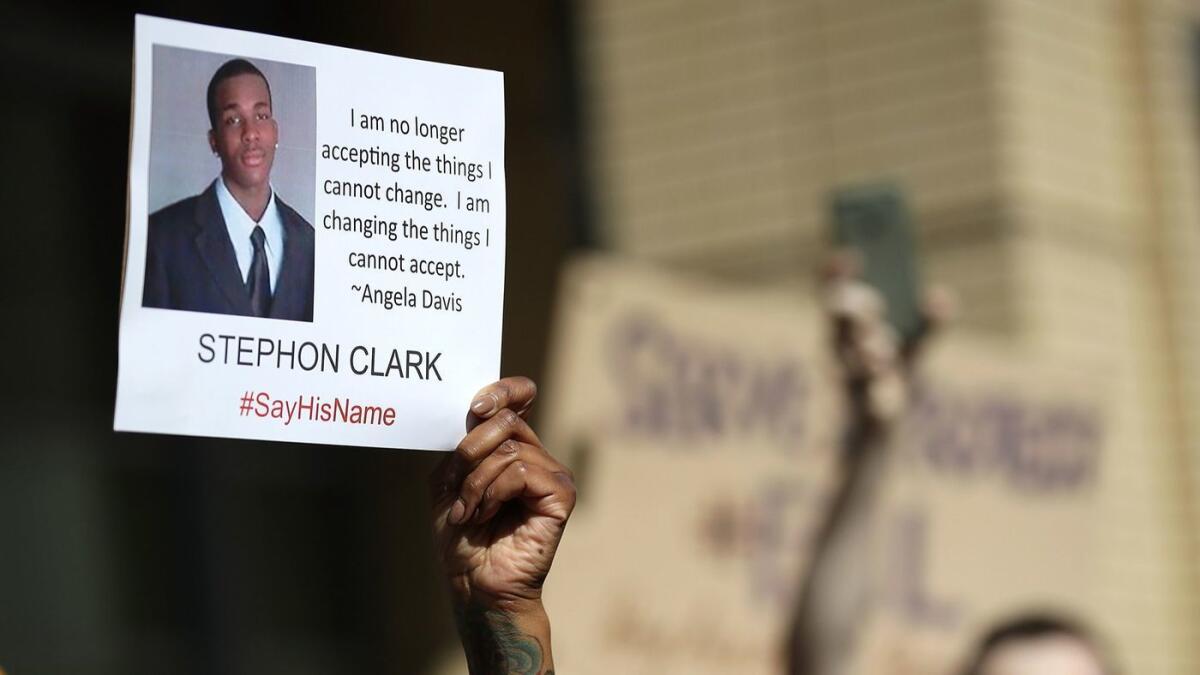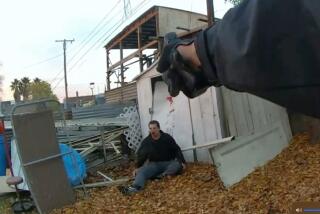As Stephon Clark lay motionless, officers thought he might be armed and ‘pretending,’ new footage shows

In this video edited from the released footage, officers call out to Clark before approaching to give CPR. The new footage can be viewed here.
- Share via
Video footage released Monday by the Sacramento Police Department shows that officers waited almost five minutes after firing their weapons to approach Stephon Clark to deliver medical aid out of apparent concern that he was armed and playing dead as he lay motionless in his grandmother’s backyard.
The revelations come after the department released more than 50 new video recordings showing the massive law enforcement response to the March 18 shooting of the unarmed black man, which sparked weeks of demonstrations and heightened already simmering tensions between police and the city’s black community.
Clark was shot at 20 times by two police officers investigating reports of somebody breaking into cars. The officers chased Clark to the backyard, where, authorities say, he turned and advanced toward the officers while holding what they thought was a firearm. Only a cellphone was found at the scene.
The new material — which follows the earlier release of footage that captured the shooting — starts as other officers respond to the break-in call and continues until fire officials pronounce Clark dead, the Police Department said. It covers 23 in-car camera videos, 28 body-worn camera videos, a sheriff’s helicopter video and two 911 audio clips.
The release of the files is a requirement under city policy, which says that the Police Department must release material associated with critical incidents to the public within 30 days. Names and parts of witness interviews were redacted from the audio.

In the many videos reviewed by reporters, there’s little discussion of the actual shooting. In them, the officers don’t acknowledge that Clark was unarmed.
One exchange is recorded by the body cameras of two police officers, a male and a female, as they approached the backyard after the shooting, joining the two officers involved.
“He have a gun?” the approaching male officer says. The two officers respond, saying a weapon hasn’t been secured.
“I don’t see it,” one says. “He hasn’t moved at all.”
The officer who just arrived remarks that Clark has one hand by his face. Moments later, they shout at Clark.
“Hey! Can you hear us?” a male officer says.
“Police Department, can you hear us?” another male officer says.
“We need to know if you’re OK,” the female officer says. “We need to get you medics but we can’t go over to get you help unless we know you’re, you don’t have your weapon.”
She suggests to her colleagues that next unit bring a non-lethal weapon: “Let’s have the next unit get, just bring a non-lethal in case he’s pretending.”
Later, in the background of the recording, one of the officers says, “Like this, something in his hands, it looked like a gun from our perspective.”
Seconds later, they begin moving toward Clark’s body. A cellphone is on the ground next to him. The officers handcuff him and one begins chest compressions.
A use-of-force expert who reviewed some of the footage at the request of The Times said the cautious approach — even after backup arrived — isn’t unusual and reflects officers’ concern for their own safety.
“One officer says he cannot see the young man’s left hand on the ground,” said Ed Obayashi, a Plumas County sheriff’s deputy and shooting expert.
Officers all fear a suspect playing possum, or pretending to be dead, he said. They may have also been concerned about another person in the house, he added.
Obayashi said the officers called for a less-lethal weapon because they had strength in numbers. “If he pulls a gun, they can shoot. But if he pulls out a knife, they can use less lethal,” he said.
In another video, a group of officers discuss muting their cameras.
In it, an officer walks up to a dark scene near a worship center and says, “Oh, fancy seeing y’all here.”
He approaches a few other officers standing in a circle.
“Muted?” someone asks. “Yes, sir,” a few reply.
“Muted?” the asker says again.
“Yeah,” a few reply.
The officer wearing the camera says, “Wait.” Then there’s a beep and the sound goes off.
The Police Department is already under scrutiny for officers’ use of the mute button in the first batch of recordings released, with some expressing concern that the agency is not being transparent. Policies on muting cameras vary between agencies. A policy implemented in Sacramento after the shooting requires officers to indicate why they’re turning off the microphone.
The videos also show officers interviewing neighbors, including a man whose rear sliding door had been broken.
Sgt. Vance Chandler said the department will look at whether the medical aid rendered and the muting of body cameras was appropriate under the circumstances.
The incident began when Sacramento police officers responded to the 7500 block of 29th Street after receiving a call about a man breaking into vehicles. The crew of a Sheriff’s Department helicopter spotted a man in a backyard and directed police officers toward him.
Deputies told police that the man had picked up a “toolbar” and broken a window to a home. The man then was seen running south, toward the front of the house, where he stopped and was looking into another car, police said. Following deputies’ directions, officers entered the front yard of a home and saw the man along the side of the residence.
Police said that the officers ordered the man to stop and show his hands, but that he ran toward the back of the home. They chased him to the backyard, where, authorities say, he turned and advanced toward the officers and was shot.
Times staff writer Angel Jennings contributed to this report.
[email protected] | Twitter: @AleneTchek
[email protected] | Twitter: @LAcrimes
[email protected] | Twitter: @haileybranson
UPDATES:
9:05 p.m.: This article has been updated throughout with more information from the videos.
This articles was originally published at 4:10 p.m.
More to Read
Sign up for Essential California
The most important California stories and recommendations in your inbox every morning.
You may occasionally receive promotional content from the Los Angeles Times.













